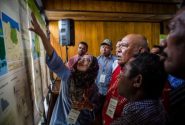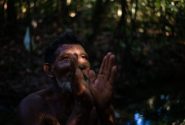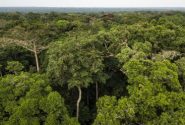
Biodiversity of forest plant and animal species (such as the clear-Winged Forest glory pictured) is inextricably linked to carbon and climate change. Jeevan Jose.
HYDERABAD, India (18 October, 2012)_After a year’s worth of analysis, a global forest expert panel has come to seven key findings showing a strong link between biodiversity and carbon and a wide array of issues that need to be addressed in schemes to reduce emissions from deforestation.
“Our intent with this project was to assess the scientific information published on the link between Biodiversity and Carbon in terms of REDD+ and offer guidance to policy makers designing REDD+ management programs and to the scientific community on knowledge gaps,” said Alexander Buck, the Executive Director of the International Union of Forest Research Organization, of which the presenting Global Forest Expert Panel (GFEP) is one component. Buck also compared the principles and procedures of GFEP with those of the expert International Panel on Climate Change, coining them the ‘IPCC of forests’.
The panel — in which several scientists from the Center for International Forestry Research (CIFOR) participated — presented their key findings during a side event at the Conference on the Convention on Biological Diversity being held this week in Hyderabad, India.
REDD+ is an international mechanism that aims to reduce emissions from deforestation and forest degradation, and foster conservation, sustainable management of forests, and enhancement of forest carbon stocks (represented by the ‘+’). The mechanism has mainly been discussed in international climate negotiations, particularly where there is interest in developing new policies to provide tropical developing countries with financial incentives to reduce deforestation and degradation rates.
The meta-analysis came to a series of key conclusions, including:
- That biodiversity is a key determinant of a forests’ ability to provide ecosystem services, particularly carbon sequestration; and to remain resilient in the face of climate change.
- Depending on how you manage forests, they will rather be a sink, a storage or a source of carbon.
- REDD+ programs must be regionally tailored as they will have variable impacts on carbon and biodiversity, depending on the management area, landscape and wider spatial scales, as wells as tradeoffs considered.
- Impacts on people should be considered early on in REDD+ planning and implementation.
- Landscape management is an important tool to reconcile social and economic aspects of REDD+.
- For REDD+ to be efficient, tenure and property rights must be clear
- There is tension between autonomous national and local REDD+ efforts and international standardisation of REDD+ safeguards.
Speaking on the issue of REDD+ safeguard tensions, GFEP coordinator Christoph Wildburger added that: “it is important to emphasise local participation in REDD+. In considering this tension, we are also given the opportunity to look at functional governance systems that are already in place.”
Speaking specifically on findings of one of the biophysical research chapters, Valerie Kapos from the UN Environment Program’s World Conservation Monitoring Centre underscored that the greatest and most immediate benefits are those that effectively reduce deforestation and forest degradation, while impacts of actions like restoring forests are seen much more slowly.
“To head off some of the discussion that will emerge, I think that the “+” takes away from the reducing trajectory. Restoring forests takes a long time and you will see the benefits of carbon sequestration before you see biodiversity returning.”

Local communities need to be better involved in forest management projects, such as reforestation programs (pictured). DW / Sascha Quaiser
The chapter looked at the deforestation and forest degradation effects of a range of management actions, including agricultural intensification, agroforestry and shifting cultivation, as well as attempts to reduce the impacts through extractive use such as non-timber forest products, hunting and selective logging.
“Each one of these actions addresses more than one REDD+ activity. These types of actions will come up again and again in REDD+ discussions, so reviewing all these impacts is helpful and will offer some sort of guidance on the impacts that need to be watched,” Kapos said.
In discussing the social and economic considerations of the link between biodiversity and carbon in terms of REDD+, chapter coordinator and University of Cambridge professor, Bhaskar Vira said that four messages emerged from existing literature on forests, people and biodiversity:
- Synergies of current programs and governing institutions with REDD+ are possible but don’t take them for granted.
- Pursuing ‘social objectives’ alongside REDD+ will increase the likelihood of achieving carbon and biodiversity goals. This could involve including local communities more through the recognition of land tenure rights and other local engagement strategies, Vera explained.
- It is important to consider positive and negative lessons already learned in the forestry sector while designing REDD+ programs.
- Trade-offs exist yet REDD+ can benefit local communities through enhanced flows of ecosystem services.
For policy makers concerned about that the time required to create research addressing the background issues of land tenure, trade offs and property rights before even starting to consider REDD+ agendas, Wildburger, says it is important to look at what is already at hand and to identify the knowledge gaps.
However the weight of such knowledge gaps need not sit on the shoulders of policy makers only. Wildburger points out that the findings on the wide array of issues that need to be addressed in REDD+ agendas should be a signal to the scientific community to conduct research targeted at connecting the dots.
“The research community is also an audience for our study,” he said.
A final draft of the analysis is expected to be completed next week and hard copies will be available at the November meeting of the UN climate convention (UNFCCC) in Doha, Qatar.
The call to conduct the meta-analysis came from the Collaborative Partnership on Forests of which CIFOR is a member. Coordination of the 45 writers and many reviewers was conducted by IUFRO.
We want you to share Forests News content, which is licensed under Creative Commons Attribution-NonCommercial-ShareAlike 4.0 International (CC BY-NC-SA 4.0). This means you are free to redistribute our material for non-commercial purposes. All we ask is that you give Forests News appropriate credit and link to the original Forests News content, indicate if changes were made, and distribute your contributions under the same Creative Commons license. You must notify Forests News if you repost, reprint or reuse our materials by contacting forestsnews@cifor-icraf.org.











